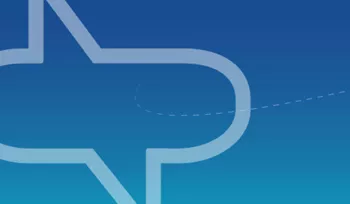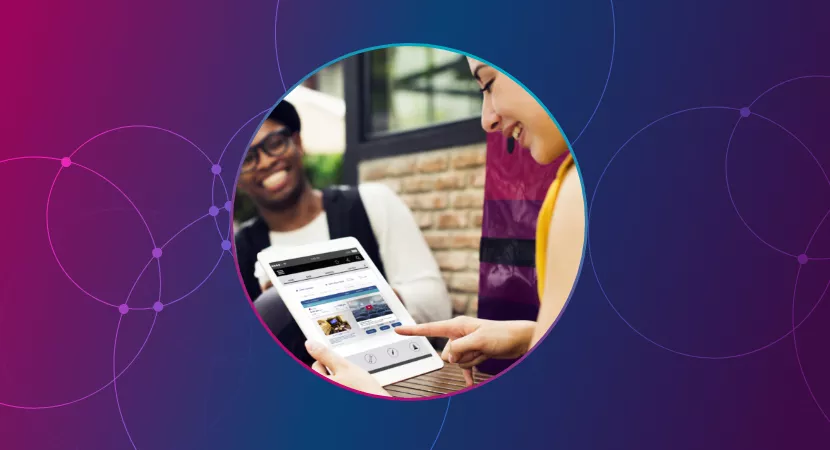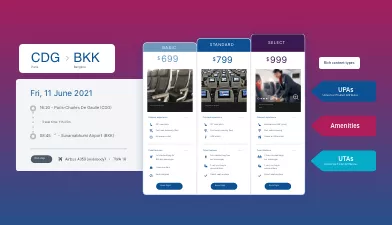On demand | Elevate 2022
Presenting @ play: Pro-level merchandising
SOLUTION BREAKOUT • MERCHANDISING
From strategy to execution, Routehappy is the ultimate merchandising solution. Hear from Routehappy subscribers on how they use visual content to improve conversion, upsell, and customer satisfaction. How can you start leveling up your offerings?
Deliver powerful, targeted, and compelling visual content to any point of sale while differentiating yourself from the competition. Ready, player? Go!
Carrie: Welcome to “Presenting @ play: Pro-level merchandising.” I'm Carrie DeMoss, Director of Pricing and Retailing Excellence at ATPCO, and I'm joined today with Tony D’Astolfo from Serko, Jeff Klee from AmTrav, and Anthony Raider from American Airlines, and today we're going to hear how they're excelling with Routehappy. They're going to show us a few things and tell us their story.
First, before we go too far into the show, we do need to take some time to read the ATPCO disclaimer. So, I'm going to stand here silent for just about 40 seconds for you guys to just read it. Once you read it, you'll understand why we're reading it. Everybody had time to get the gist of it anyway, yeah. Alright, thank you for indulging us, taking care of the legal stuff. Our lawyers will be happy about that.
So why merchandising?
So, you've heard throughout the conference yesterday and today, the travelers want to see beyond fare and schedule. They want to understand their value and have choice. And they actually also want control over their flight experience.
So, price is not just a price any longer. The most crucial piece of information is not about price. So, airlines have invested significantly in their products, their services, and the flight experience. And visual information about airlines, services, and products are often nonexistent in the flight shopping world. So, it's time to move our flight shopping to the modern retailing world, and get flight shoppers more than just price and schedule.
So, our consumer research has shown there is a clear demand for more visuals, more transparency, and more choice. So the ATPCO 2022 Annual Flight Survey validates the idea that flight shoppers expect more than just a price to make a purchase decision. The results were obvious. 80% of our flight shoppers are more likely to book a flight with targeted visuals that effectively merchandise flight options over commoditized displays focused solely on price and schedule They want visuals of seats, entertainment, sustainability efforts and more.
A visual experience is a demand for flight shopping. 96% of our responders said images would enhance their flight shopping experience on mobile and 63% of flight shoppers prefer to see images. 70% of shoppers want to purchase extras when flight shopping through online travel sites. So, some good numbers here.
So, this is where Routehappy comes in. It's the first step towards differentiating and personalizing the value of your travel offer in the order to leverage your relationship with your travelers. There are many benefits that can be realized from integrating Routehappy into your sales channels.
Routehappy opens the door to the countless merchandising opportunities, enables us all to improve our customer satisfaction, drive conversion, increase upsell, and unlock untapped revenue.
Routehappy benefits the entire value chain. Airlines see value in using visual content to differentiate and monetize their products and also see value in having that content distributed in all their channels around the world. Routehappy helps consolidate and structure their visual content and channels to sell and travelers to buy.
So, with access to Routehappy's content, including pictures, headlines, and descriptions, channels can deliver a more comprehensive service and experience to flight shoppers. Then, travelers who are looking to book, they can get a better feeling of what's included in the offer.
So, merchandising across every channel with Routehappy is a win-win. Deliver a consistent message once. And distribute it across all channels. If you’re already merchandising or planning to merchandise on our own website, Routehappy can be the repository for that content and more, and get your story out to your direct and your indirect channels. You have deals and agreement with your corporate travels. Routehappy can enable you to customize and showcase those offers. And in your leisure channels, you can showcase your premium products and encourage upsell.
I think we've heard this week on a few occasions of how just showcasing those higher products are actually selling. But now let's hear from Serko, AmTrav, and American Airlines on how they're winning at the game. Tony, would you like to join us?
Tony: Absolutely. Since there was a disclaimer, I can use profanity.
Carrie: It didn't say no!
Tony: I won't do that. Come on now. Alright, I'm very excited to be here. Thank you ATPCO for inviting us. We're a big fan. I'm also excited to be out with everybody back in person, but most excited about the fact this is the first time I've ever had an avatar. Usually I just have TD, right?
Anyway, how many of you have heard of Serko? Show of hands? Alright, maybe half the room. Marketing is working fairly well. We're an online booking tool and expense in the corporate space. We are headquartered out of Auckland, New Zealand. That's why you hear the accent. See, I'm a Kiwi. And we've been around for a while with market leader there. We launched here in North America about four years ago. So, I run the North American division.
And when we think of technology, we think. of it through the lines of four constituents, okay. So, anything that we develop, that we're going to put in the market, we're thinking of the traveler and the corporate side, the travel buyer, the travel management company who's been hired by the corporation to help them manage their travel program, and then finally the supplier, many of you that are in room today.
And when we think about it, they all have different challenges. And our job is to satisfy all of their requirements without having anyone of them sacrifice If it's a bad user experience at the front end so the traveler can't get through the thing easy, not good. If we've done something that can't be serviced by the travel management company, not good.
So we're trying to think of all four constituents whenever we develop the technology. And we were pretty early with Routehappy. And when I said I was going to put this slide up, they were like, well, we don't even do the universal passenger attributes anymore, but the reason why I bring it up is because when we hit the pandemic, and the industry pretty much stopped flying, there was a resistance, particularly in a business travel site, to get back in the air. There was a lot of uncertainty about what the experience was going to be, especially around cleanliness of what a lot of the airlines were doing.
And so, Routehappy stepped up really fast and, all of a sudden, we got a ton of information that said, “this is what each airline is doing relative to making it safe for you to travel.” So, I call them out for that because I thought it was a phenomenal job that they stepped up and really helped the industry, which is what they're trying to do.
Now in terms of how we use the application, there are only four pages on the Zeno application, okay. We start with kind of a request page, and we move to the search page. So, page number two is where we bring back all the content, right at the point of purchase, that we think is relevant to inform the traveler to make a very good decision.
On the page, we leverage Routehappy extensively. So, that's where you guys get to market to your best, highest-yielding customers. You get to differentiate between the fare categories, right. So, if you look here… airlines across the top, then we'll drop down and there'll be a screen that'll say all of your fare brands. As the user clicks on any one of the brands, the Routehappy content changes and we tell them both with written and then with pictures, okay. It's been hugely successful. For informing the travelers what they're going to get when they buy on a particular airline.
So, you be the judge. On the left-hand side, I'm going to call out JetBlue. They don't participate in Routehappy. That's what they see. And then we compare it. This is the same city pair, JFK, LA. So, without Routehappy content. With Routehappy content. I can tell you that we get feedback. In our feedback, every page has a feedback loop. Customers will actually say there's something wrong with the application because I'm not seeing the pictures, I don't see the carousel. They don't get that great description, right. So, vitally important for us and we're absolutely seeing customers respond to the Routehappy content.
Now the third page, so that's the search page. The third page we moved to is our extras page. So the extras page is where we give you the opportunity to select your seat, understand a little bit more about bags, and in the ancillaries, and to also upsell. So when we move to the extras page. We're trying to replicate the eairline.com flow.
So typically what you do is you buy your flight and you get into a secondary phases, what do you want to add to your flight? So that's what our extras page does. It's basically embedded in the workflow.
In the corporate space, historically, online booking tools didn't do this and what happened was the traveler would buy a flight, and then they would go to the airline.com, pay for baggage, early check-in, whatever it is, and then when they get to reconcile, the travel manager would say, “How come a $300.00 flight ended up costing $420?” Alright, those two things were reconciled.
So, very important for us to bring that, again, to the point of purchase within the workflow and allow them to say, okay, this is the extras page, what can you do here? I can open up a seat chart and then I can see what I'm going to get or what I could potentially buy. I'm going to show you the upsell opportunity.
This is, it's a little grainy, but this is someone who has status. We're also going to pull in their loyalty number and we're going to represent on the seat chart that they can sit anywhere. Preferred seats would have a 0 price point. If you don't have status, and you can't see this, but it will show you that these are 59, these are 39, right.
So, if you are, from our perspective, right at the point of purchase within the workflow, we're allowing the airline to say, okay, they don't have status or they have status, I'll recognize that… they can sit wherever they want. They don't have status… I can execute and upsell to a different seat and before they check out know the full price of the of the ticket.
So, that's just a little bit of an example of how we're using Routehappy. Like I said before, we're a huge fan. We were early. We love what they do. We want to have them continue doing stuff and actually I saw some things the other day when we were talking about Frontier and how Frontier is using information to pull out. I'd love to get more graphic here, this coming from the GDS and all I can really do is show the seat number and then put a price tag on it, but I'd love to get more graphical there. So that's your next homework assignment. Thank you, I'll turn it over to Jeff.
Jeff: Hi everyone. I'm Jeff Klee. I'm the CEO of Amtrav and cheapair.com, and I'm going to wear my cheapair.com hat for this presentation, but everything I'm saying applies for Amtrav, too.
I'm going to start with a story that really happened. Three weeks ago, I found out I had to be in Chicago for a last minute meeting on a Wednesday and I live in Los Angeles and my challenge was that I coached my son's baseball team and he had a game on Tuesday night and I really, really wanted to be at that game. So, I decided I'm going to suck it up and take a red eye flight. I also decided I'd spring for first class tickets to make it a little bit more bearable, but still it was not something I was looking forward to.
So, I went to our site to book my flight and I saw that American and United had flights at about the same time and about the same price. Now, we use their Routehappy UPA's and I love them. I always check the images of my plane before I book something.
So, I did that. I checked American and about what I expected and your kind of standard domestic first class. And then I checked United and holy ****.
Tony: Disclaimer, disclaimer works.
Jeff: Thank you, Tony for giving me that license, but I mean look at this. They're flying up a lie flat bed with the pod I could definitely sleep on that plane. So, and just to give you a little context here, I'm a Platinum Pro member on American and I'm not just saying this. I love American. I fly American all the time, but I mean in this case, I, because of the UPAs, I went against my status and I booked the ticket on United. It was a great flight. I slept for three hours. I was coherent the next day. United got a revenue first class ticket.
So, it was win all around and it makes me wonder why every airline doesn't embrace these UPA's. If you've got it, flaunt it right, why? Why would you not want to show that which makes your product special or different?
And the reason I hear a lot is that airlines doubt that it will make a difference, especially in consumer sites. They say nobody gives a damn about this stuff. They all, everybody is just obsessed with the price, maybe the schedule, and this stuff won't move the needle. And I'm sure that's true for a lot of travelers, maybe even the majority. But when we obsess over the travelers that are backfilling the planes, we're missing the point.
And that is, that this stuff matters most to the travelers that are the most valuable, and I'm talking about the premium cabin travelers, or the road warriors, or the affluent leisure travelers who, on any given trip, they might choose economy, premium economy, or business depending on the deal, the route, and the product. There are persuadable people.
And in fact, we had right before COVID, we were experimenting with a new consumer brand and we had the same display that you just saw. Delta told us that when it came to selling someone a product higher than the least expensive, we did that twice as often as other OTAs. So, this stuff works.
Now, the other reason that I hear from airlines as well, we don't really believe that the channels are going to display the content. I know there was a one point this kind of chicken egg thing where the airline. The bookings sites didn’t want to create space for content that didn't exist, and the airlines didn't want to create content if the space didn't exist on the booking side. We're past that now.
We've got our chickens and we've got our eggs. There's I think, ATPCO and I've got like 20 plus airlines in the premium UPAs… 31. And booking sites, especially in the corporate world, I see, every month I feel like I see, a new startup doing something really innovative with merchandising displays. Really cool stuff. So, I think we've got that critical mass now and I mean let's face it, it's 2022 now. I think we can all agree it's time that shoppers get the same experience that they get when they're buying an airline ticket, that they get when they're buying everything else.
And that means seeing all the options, being able to choose any of the options, but really importantly, having enough context around the options like the images, the descriptions, so that they can make an intelligent choice.
Anthony: Thanks, Jeff. I found myself sitting on the front row of, like, church and wanted to shout “Amen!” to a lot of points that Tony and Jeff were making. Thanks.
I'm Anthony Raider. I look after the distribution strategy grou at American Airlines, and we've actually rebranded ourselves, just recently, to where our organization is now called “airline retailing.” So, it gives a little flavor to what we're focused on as we move forward.
So, I got asked to come share the airline story on why we've partnered with Routehappy and how we're utilizing the assets and the content available. For us, it really focused on three main decisions and three pain points, really, when we thought about partnering with Routehappy. We've been at this modern retailing journey for quite some time. Earlier today you heard folks saying, oh, it's been over 10 years… trust me, we know it's been over 10 years, but Routehappy has been a critical part of that retailing journey for us and we'll be going into the future.
First, around customer confusion. So, what we found was airlines, well… we didn't find this out, we knew this. Airlines are very complex. Our fare rules change all the time, our policies change all the time, and I know a number of like Curtis and Cleary and others that work for airlines, some of us got asked to go work during the pandemic at the airport. I myself volunteered at DFW Airport a number of times during the summer. And when you talk to customers, you realize a large majority of them were traveling for the first time that year, and a number of them have never been in an airport before in their lives. And it just shocked me.
So, you can imagine the anxiety they had shown up to the airport, and you can imagine the anxiety they had when they're buying their ticket, not knowing what they're getting into. And what we found that this was driving about hundreds of thousands of calls into our customer contact centers. So, folks would pick up the phone and call RES and ask questions about fare rules, ask questions around product, ask questions around does this flight have Wi-Fi on it or not. So, those are very simple calls, but it takes time away from our RES team members. Servicing a more complex situation leads to higher call times.
So, we wanted to shift away all of those calls into our RES center and so that's where rich content comes into play and it's been a critical piece in in lowering the call volume into our centers.
Customer perception. So, Jeff and Tony hit on this already. Sometimes it works in your favor, sometimes it doesn't, such as Jeff's example. But I mean who here, it's 2022 to Jeff's comment, who here would buy anything online without a photo? I mean just think about it. Like can you imagine going to Amazon today, and buying a product without photos? Just it boggles my mind.
So, and then customer trends. Carrie, you touched on this. When we started the numbers were probably a bit lower because we've been at this for a number of years, but now, it's just it's basics. You’ve got to have rich content in your display, and so we're excited about where the industry is going.
So, Routehappy partnership for us is both direct and indirect, and we have a very robust library of content for our third-party partners to use, as well as our own direct channel. And tell you a little story. Routehappy partnership with American started within our distribution group.
So, our distribution team, before I even joined the group, went out and started a relationship with Routehappy and we didn't have a lot of traction, to be honest with you. Our repository wasn't great. And so, the learning that we had as an airline was when we started to expand that to our direct channel and our direct channel got involved using Routehappy content. Our marketing team all of a sudden was very excited about creating content.
So, we got a lot of content created and it's one unified, I would say, voice, or product representation, that our marketing team creates and it's used across all of our channels. So, it creates that consistency for customers. Whether, and we know customers cross shop, so as a customer is shopping on Zeno, or they’re coming to American Airlines, or Expedia, they're seeing a similar UPA and similar product representation in those channels.
So, we have a wide array of universal product attributes. We add more every single day. We were early adopter. Thank you for the reassurance UPAs. Those were critical in our recovery and communicating all the pandemic policies that we had. And we're using them also to communicate on codeshare partners.
So, we've been, as an industry, doing codeshare quite a bit for a very long time. American Airlines has a robust codeshare partnership with number of carriers and what we found is, especially with our JetBlue and Alaska codeshare partners, is customers still don't know what to expect when they get to the airport. Sometimes, they don't know who to check in with, especially one-time customers, or who to buy the seat from. So, UPAs are helping us communicate that traveler experience at time of purchase for our codeshare relationships.
So, here's just a couple of partner engagements that I wanted to throw up here. We got a consumer site with Kayak and then we have Zeno highlighted here. You can see they both integrate the content differently. It's the same library of content, but they’ve chosen a different path, which we think is great. We'll have the data there, we'll have the content there, and then the channels know how to integrate the content in the most effective way that drives conversion.
So, one thing that stuck out to me was Zeno being a corporate B2B platform, they've chosen in the carousel to highlight our sustainability UPA. So, sustainability is a heavy, really important topic in corporate travel today. So, brings that front and forward, as well as our mobile app promotion as well, for those corporate travelers. And then we're also using a Routehappy to help drive engagement for our elevated offers that we have available through our NDC API.
So, for American, we have a couple. One is named main select, another with main plus. And so, we've created, and we're starting to pilot this, we call them “custom categories” to where you can use an UPA to better communicate what is in the bundle that the customer is purchasing.
And then, of course, another example of a B2B platform is Spotnana, who recently launched… one of those startups Jeff was talking about. And this is just a great example of how they've integrated it differently, as well in terms of rich content, but also brings forward how they're bringing the Routehappy content into the mobile device and bringing that to the customer.
Carrie: Alright, thank you. So, before we let the guys off the hook, does the audience have any questions that you'd like to ask them? No questions. Very clear. You're all going to go, if you're not already, a Routehappy customer, you're going to go sign up to become one. Here we go.
Audience member: Is there a certain content that customers…. [inaudible]
Tony: On our side, we don't measure… well, we are starting to measure where they land and what they look at. I don't have any stats for you, but most of what it is, is towards the business side of the trip.
So, sustainability is actually a big one, having engaged with the mobile app, as Anthony said is another big one, and seats is a huge one. They will mostly try to figure out, hey, what's my comfort level going to be on this particular flight depending upon the fare? Can I get a seat in advance? Is it going to be a good seat? So those are the three that kind of popped in mind, Jeff.
Jeff: I would say the amenities are really big like things, like Wi-Fi and live TV, and we have the ability to filter based on those. But then beyond, that like Anthony said, people just want to see a picture. That is how you're used to shopping for other things. So I think the UPAs specifically are great for that.
Carrie: Yeah, I would also just add on top of that, that in all of our conversations with the customers who are using the content they are letting us know that… because we have some of our content is just more graphics and some are more photos, right. And they're really looking for more of the actual imagery, photos over graphics. And I think that was one of the stats that we saw, too, but yeah, so, that's something we do offer up some graphics, but the biggest success is come from actual real photos of the experience.
Audience member: [inaudible]
Anthony: No, it's that's a great question. It's actually something our marketing team is keenly focused on, is making sure that the photo that we have with a seat is as close as humanly possible to what the seat is going to be that the customer is sitting in. And so, prior to last couple of years, we didn't really have a lot of seat assets.
We didn't use the UPA that highlighted seats for that concern, but since American has gone through a harmonization effort with our domestic fleet, we have the Airbus A321 as well as the 737, they’re all in similar configuration. We really leaned into the seat UPAs and totally revamped our asset library when it comes to seats.
[inaudible]
Anthony: Yeah. Well, there’s always going to be day of travel potential downgrades or change of equipment, and you're not going to solve for that, but you want to definitely solve for where the controllable experiences that you can.
Carrie: Yeah, I would say it probably also opens up a use case where when you're doing a schedule change and you know it's an aircraft change and you're communicating in advance to the customer through e-mail, et cetera., you could offer up the additional images (if they're different) for their for their new aircraft so they're aware of what to expect in that change. So, there's another use case that that could be implemented pretty easily.
Tony: But it's a great point to your point. So, how many of you use TripAdvisor? And you see the hotel pictures and then you see the pictures people post, right? So that's a great point. And I think to Anthony's point, you really have to harmonize and make sure that the pictures you're showing equals the product they're going to.
Audience member: Same with targeting. We target to the subfleet. So we have pictures for AA or any of our airlines. We have pictures for that subfleet. So, in the shopping process, we’re only sending back images with that particular aircraft and that particular configuration. The change is last minute, like Anthony said.
Jeff: Yeah, and I can add onto that. I mean, we’re maniacal about that desk in the room… he knows I drive him crazy with it. We won't show a picture unless we're positive that it is to this subfleet level. And so, I think ATPCO does a great job of that. They don't put them out unless they know it's going to be the right plane.
Audience member: So, I'm gleaning here. I don't know much about the Routehappy product. I'm gleaning just by this discussion, that then the hook to the Routehappy data, the key to it, is aircraft type and the carrier, right? I’m wondering what the hook is back to ATPCO fare data, the CAT1631, 33, type of all the data. What’s the Routehappy hook back to that or is there one there?
Carrie: There is one for optional services, which is the S5, S7 for those of you don't know that one. There's a subcode. The subcodes can be used. As well as for branded fares. The brand name can be used to do that connection. So, when things are targeted to a specific fare, then all the security connections to that fare have to be followed. So, the branded fare information. So, we need to know who's asking and so we do, and connect that fare with the appropriate branded fare rule, etc., information. Angela?
Audience member: And it’s not based on the subcodes that you have, right?
Carrie: It is.
Audience member: [inaudible]
Carrie: So, if the airline wants to connect… So, for ancillaries, for example, with if they want to put the right imagery for their various ancillary products that they offer, they could connect it to the optional services record where they would have that S7 subcode completely connected to that. So, when we're going to go down that path with an airline, we talk to them about making sure all the data is aligned, yes.
Any other questions? Good questions, good conversation.
Audience member: I have another question, Carrie. It’s something that I’ve been asking for a long time. It’s about penalties.
Carrie: Penalties, yes.
Audience member: So you can have a penalty, but if we don’t what the true penalty is… [inaudible]
Carrie: So, you're talking about when we put out a UTA, connect it to the penalty information. For that level, we keep it at the very highest level. Is it changeable and if so, is there a penalty or is it refundable or is there percentage etcetera? So, we try to add that, yes.
So, her question, in case you couldn't hear at the back, which I'm sure you couldn't, had to do with connecting the actual fare role penalty information to the Routehappy content. We use the actual fare data to create that content.
Alright well, first I want to thank Tony, Jeff, and Anthony for sharing their story with us today. ATPCO and the Routehappy team applauds you for the work that you're doing with us and changing and driving forward real airline modern retailing in the business. So, we really applaud you for that. And sharing your story today and showing to the audience where you are and how you value it is very much appreciated.
Clearly, you can see that modern merchandising has actually landed. So, if you're considering merchandising, talk to us. If you're not considering merchandising, talk to us. Because we think you should all be considering it.
The story that we've been talking about yesterday and today is about bringing the industry forward and so now is the time. So, we look forward to those many conversations. We have one other opportunity or maybe two other opportunities this afternoon to stop by our merchandising kiosk and ask questions. The teams that are working that will have plenty of information to share with you and can set up some one-on-one time with you if you'd like.
So, thank you for your time today and we look forward to talking to you and seeing modern retailing come alive on every channel where travelers shop.
So, thank you very much!
An event experience you can't miss
ATPCO's Elevate + ARC's TravelConnect
Speakers

Jeff Klee
CEO, AmTrav
Jeff is a self-described computer geek who developed and sold his first video game at age 13. In college, he and a buddy got a crash course of the airline business while planning their backpacking trip and later used that know-how to help others save money on airfares. They founded 1-800-Cheap-Air in a University of Michigan dorm room in 1989. When the company took off, Jeff ditched his law school plans to combine two passions—travel and software development. CheapAir.com was born, and soon after AmTrav for Business, which together serve almost 400,000 travelers annually. Jeff grew up in Los Angeles where he still lives with his wife, two kids, and golden retriever, none of whom want to be anywhere near him when the Dodgers are losing.
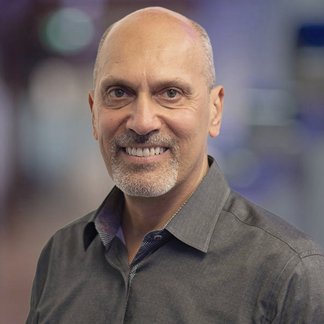
Tony D'Astolfo
Senior Vice President, North America , Serko Ltd.
Tony is a 35-year travel industry veteran and an accomplished executive with deep expertise in travel and technology. He joined Serko in 2018 to lead their efforts in North America. Tony was previously Chief Commercial Office at Deem, where he was responsible for developing and driving the commercial strategies for all sales, marketing, and customer-related activities. Previously, Tony was Managing Director of Phocuswright and Chief Sales Officer for GroundLink, and his industry career began at GetThere and United Airlines. Tony is a long-time member of GBTA and he has served as advisor and mentor to a number of early stage travel start-ups.

Anthony Rader
Director of Distribution Strategy, American Airlines
Anthony’s focus is on creating a world-class customer experience through innovative distribution partnerships and technology including IATA New Distribution Capability (NDC) strategy. Since joining American in 2010, he has held various roles in the Commercial organization, including managing a sales territory, leading yield management strategies for American’s domestic route network, launching revenue strategies, and domestic sales strategy. Anthony holds a BBA degree from Texas Christian University, as well as an MBA from Cox School of Business at Southern Methodist University. He lives in Dallas with his wife and two children and is the fourth person in his family to work for American Airlines (his grandfather, uncle, and mother all retired from the company after long careers).
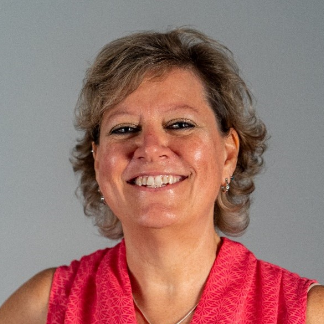
Carrie DeMoss
Director, Pricing and Retailing Excellence, ATPCO
Carrie has led ATPCO’s marketing and development of ATPCO’s Ancillary Revenue Solutions, Optional Services, and Branded Fares as well as Reissues and Refunds. Today, Carrie’s passion for airline retailing continues as she leads Pricing and Retailing Excellence at ATPCO. Carrie is responsible for the alignment of ATPCO teams around airline and air travel retailer needs and priorities. Additional responsibilities are onboarding and integrations of Architect, Express Contracts, Pricing APIs, Uploads, and Routehappy to ensure our partners’ business value is achieved. Before joining ATPCO in 2006, Carrie spent 11 years with American Airlines and almost 10 years at Sabre, where she focused on fares and pricing development.
You might also like
